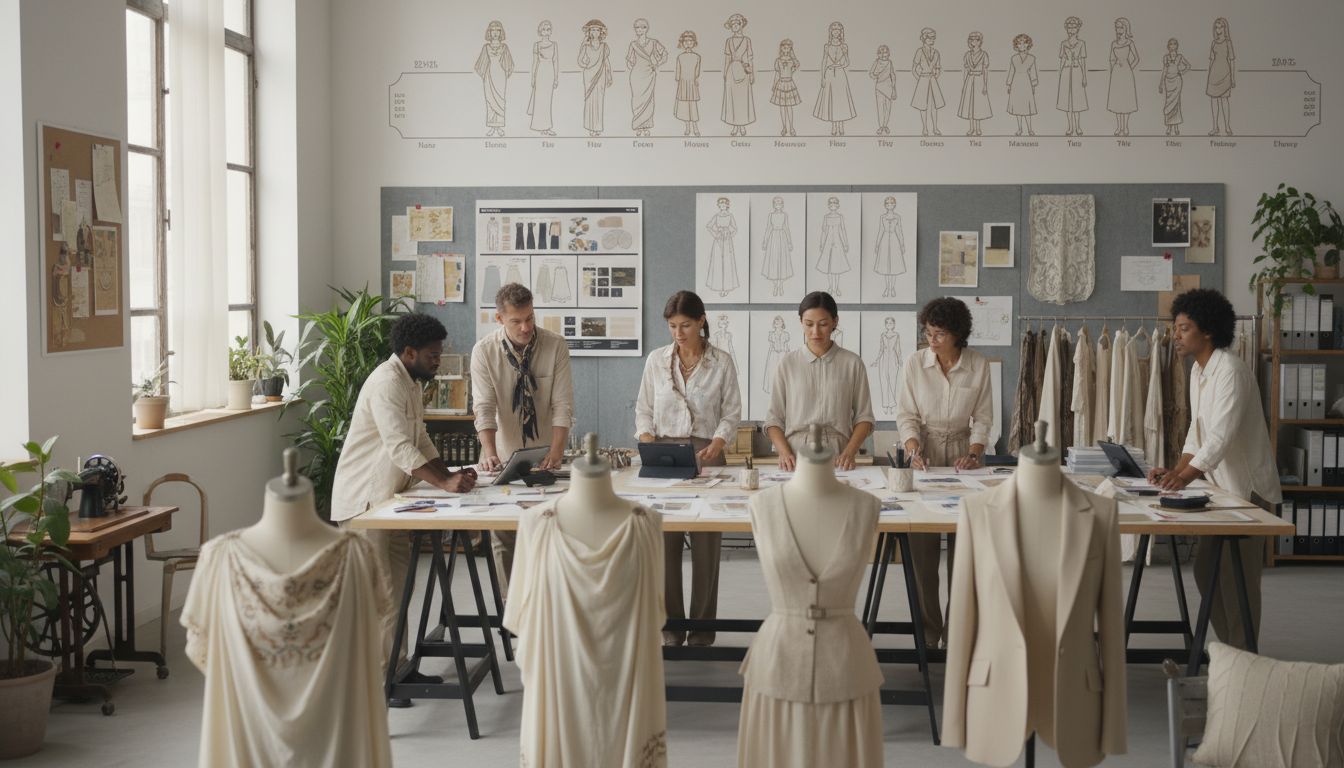Complete Guide to Design History of Women’s Clothing
Over centuries, women’s clothing has shaped and mirrored dramatic social change. Fashion is never just fabric and thread—it tells real stories of rebellion, resilience, and evolving identity. Historic shifts like the move from Victorian corsets to flapper dresses marked turning points in how women lived and saw themselves. Learning about design history in women’s clothing offers insight into the forces that changed roles, challenged norms, and inspired generations toward greater self-expression.
Table of Contents
- Defining Design History In Women’s Clothing
- Major Eras In Women’s Fashion Evolution
- Cultural And Social Influences On Style
- Iconic Designers And Signature Contributions
- Modern Interpretations And Ongoing Trends
Key Takeaways
| Point | Details |
|---|---|
| Cultural Reflection | Women’s clothing design history encapsulates cultural transformation, highlighting the interplay between societal norms and personal expression. |
| Evolution of Fashion | Each historical era in women’s fashion represents significant social and artistic shifts, marking women’s evolving roles and identities. |
| Impact of Designers | Iconic designers have redefined women’s fashion, challenging conventions and enabling personal storytelling through innovative designs. |
| Current Trends | Modern fashion prioritizes sustainability and inclusivity, reflecting a dynamic dialogue around identity and ethical production practices. |
Defining Design History in Women’s Clothing
Women’s clothing design history represents far more than fabric and threads.
 It’s a powerful narrative of cultural transformation, social movements, and personal expression that weaves together societal shifts and individual creativity. From restrictive corsets to liberating pantsuits, clothing design chronicles women’s evolving roles and identities through visual and tactile storytelling.
It’s a powerful narrative of cultural transformation, social movements, and personal expression that weaves together societal shifts and individual creativity. From restrictive corsets to liberating pantsuits, clothing design chronicles women’s evolving roles and identities through visual and tactile storytelling.
At its core, design history in women’s clothing examines how garments reflect and shape societal norms, technological innovations, and personal empowerment. Each era’s fashion tells a nuanced story about women’s social standing, economic opportunities, and cultural expectations. Victorian-era dresses revealed strict social hierarchies, while 1920s flapper styles symbolized emerging female independence and rejection of traditional constraints.
The discipline of studying women’s clothing design involves analyzing multiple interconnected elements - from textile technologies and manufacturing techniques to social movements and individual designer contributions. Fashion Through the Decades: Complete Guide reveals how clothing serves as a dynamic canvas reflecting broader human experiences. Researchers explore how garments communicate complex narratives about gender, power, rebellion, and self-expression.
Understanding design history requires recognizing clothing as more than aesthetic objects. They are living artifacts that document women’s struggles, triumphs, and continuous reimagining of personal and collective identity. From suffragette white dresses to modern performance wear, each design represents a chapter in women’s ongoing journey toward autonomy, comfort, and authentic self-representation.
Major Eras in Women’s Fashion Evolution
The journey of women’s fashion is a fascinating narrative of social transformation, artistic innovation, and personal liberation. Each historical era represents a unique chapter in how women expressed themselves through clothing, reflecting deeper cultural shifts and societal expectations. From restrictive Victorian silhouettes to the bold statements of 20th-century fashion, these transformations tell a powerful story of female empowerment and self-determination.
Key Fashion Eras dramatically showcase women’s evolving social roles. The Victorian period (1837-1901) characterized women’s fashion through corseted waists and layered, voluminous skirts that symbolized domestic confinement. In stark contrast, the Understanding 1920s Style Women: Fashion and Influence reveals how flapper fashion dramatically challenged these previous constraints. Shorter hemlines, looser fits, and reduced corsetry represented women’s emerging economic and social independence.
The mid-20th century saw radical fashion transformations mirroring significant social movements. World War II introduced practical, utilitarian styles as women entered workforce roles traditionally held by men. The 1960s and 1970s brought revolutionary designs that challenged gender norms - pantsuits became symbols of professional ambition, while mini-skirts represented sexual liberation and rejection of conservative dress codes. Each garment became a statement, transcending mere clothing to become a form of social communication.
Modern fashion continues this trajectory of personal expression and social commentary. Contemporary designers increasingly challenge traditional gender boundaries, creating fluid, inclusive designs that celebrate diversity. From sustainable fashion movements to gender-neutral clothing lines, today’s fashion landscape represents an ongoing dialogue about identity, freedom, and individual choice. Women’s clothing has transformed from a restrictive social uniform to a powerful medium of personal storytelling and empowerment.

Cultural and Social Influences on Style
Fashion is far more than fabric and design - it’s a powerful language of cultural expression, social dynamics, and personal identity. Throughout history, women’s clothing has served as a visual narrative reflecting the complex interplay between societal norms, political movements, and individual agency. Each stitch, hemline, and silhouette tells a story of struggle, liberation, and transformation.
The Victorian dress reform movement dramatically illustrates how clothing can be a form of social protest. Women’s suffrage and Western women’s fashion through the early 20th century reveals how women’s clothing became a strategic tool for challenging restrictive social expectations. During this period, reformers advocated for more practical, comfortable clothing that allowed greater physical movement, directly challenging the era’s constraining fashion norms that symbolized women’s limited social roles.
Religious, economic, and political contexts have consistently shaped women’s fashion choices. The workplace revolution of the mid-20th century, for instance, saw women adopting structured suits and practical workwear as they entered professional spheres previously dominated by men. Understanding the Influence of Music on Fashion further demonstrates how subcultures and artistic movements profoundly impact style, with each musical era bringing its distinctive fashion statements that reflect broader social attitudes.
Today, fashion continues to be a dynamic dialogue about identity, resistance, and personal empowerment. Contemporary designers increasingly challenge traditional boundaries, creating inclusive designs that celebrate diversity and individual expression. From sustainable fashion movements to gender-fluid collections, modern style represents an ongoing negotiation of social values, personal freedom, and collective cultural narratives. Women’s clothing has transformed from a restrictive social uniform to a powerful medium of self-definition and social commentary.
Iconic Designers and Signature Contributions
The landscape of women’s fashion is a testament to the visionary designers who transformed clothing from mere fabric to powerful statements of identity, creativity, and social change. Throughout history, these innovative creators have challenged conventions, redefined beauty standards, and empowered women through their groundbreaking designs that transcended traditional aesthetic boundaries.
Designer narratives reveal profound cultural transformations. Defining Designs highlights Donna Karan’s revolutionary approach, particularly her ‘Seven Easy Pieces’ concept that redefined professional women’s wardrobes. Karan understood that modern women needed versatile, practical clothing that could transition seamlessly between professional and personal spaces, creating designs that celebrated both sensuality and functionality. Her iconic Cold Shoulder dress became a symbol of women’s evolving professional identity, breaking down rigid dress codes with intelligent, adaptive fashion.
The 1970s marked a particularly explosive period of fashion innovation. 1970s in Fashion demonstrates how pop culture icons like Madonna became transformative style architects, blurring boundaries between music, performance, and fashion. What is a Signature Look: Understanding Personal Style illustrates how these designers didn’t just create clothes - they crafted entire visual languages that allowed women to express complex, multifaceted identities through their wardrobe choices.
Today’s designers continue this legacy of innovation, creating collections that challenge gender norms, celebrate diversity, and prioritize sustainability. From Vivienne Westwood’s punk rebellion to Rei Kawakubo’s avant-garde deconstructions, these visionaries prove that fashion is never just about clothing - it’s about challenging societal narratives, expressing individual freedom, and reimagining what’s possible. Each collection tells a story, each design is a statement, and each stitch represents a moment of creative revolution.
Modern Interpretations and Ongoing Trends
The landscape of women’s fashion is experiencing a profound transformation, driven by technological innovation, social movements, and a reimagining of personal expression. Today’s fashion is no longer about conforming to rigid standards, but about celebrating individual identity, sustainability, and global interconnectedness.
Contemporary fashion trends reveal a nuanced narrative of change and adaptation. The Evolution of Women’s Fashion and Makeup traces the remarkable journey from bold 1980s extravagance to minimalist, purposeful design. This shift reflects deeper cultural changes - women are no longer seeking to stand out through ostentatious clothing, but through authentic self-expression and meaningful choices. How to Find Fashion Inspiration: Fresh Ideas for 2025 captures this ethos perfectly, emphasizing personal style over trends.
Sustainability and ethical production have become central to modern fashion philosophy. Designers are increasingly prioritizing environmentally conscious materials, transparent supply chains, and inclusive sizing that celebrates diverse body types. The rise of gender-fluid fashion challenges traditional binary clothing categories, offering collections that transcend conventional definitions of masculine and feminine. Technology plays a crucial role, with digital platforms democratizing fashion creation and allowing unprecedented global creative exchange.
The future of women’s fashion is a dynamic, borderless ecosystem of creativity. From AI-driven design processes to virtual fashion experiences, the boundaries between physical and digital style continue to blur. What remains constant is the fundamental power of clothing as a form of personal storytelling - a medium through which women articulate their complex, multifaceted identities with courage, creativity, and uncompromising authenticity.
Discover the Story Behind Every Stitch and Elevate Your Style Today
The history of women’s clothing design teaches us that each piece of fabric has a story to tell about empowerment, transformation, and bold self-expression. If you are inspired by the journey from Victorian corsets to modern versatile wear, Be Juliet offers a way to live your own fashion narrative. Our carefully crafted collections blend timeless elegance with contemporary ease, helping you embrace every facet of your identity through clothes that feel as real as your story.

Explore our latest arrivals in the New In collection for fresh designs that honor the past while celebrating your unique style. Whether you seek sophisticated blouses for confident days or casual crop tops that capture your free spirit, Be Juliet supports your evolution. Start your own fashion revolution now with pieces that empower you to redefine love, comfort, and femininity at Be Juliet. Step into the future of women’s clothing with us today.
Frequently Asked Questions
What are the key historical eras in women’s fashion design?
Key historical eras in women’s fashion design include the Victorian period characterized by corseted dresses, the 1920s flapper styles symbolizing women’s independence, and the mid-20th century which reflected social movements such as women’s entry into the workforce.
How has women’s clothing reflected social changes throughout history?
Women’s clothing has reflected social changes by mirroring shifts in societal norms, economic opportunities, and political movements. For example, the transition from restrictive garments to more practical and expressive pieces illustrates women’s evolving roles and identities.
Who are some of the iconic designers in women’s fashion history?
Iconic designers in women’s fashion history include Donna Karan, known for her versatile professional wardrobes, and designers of the 1970s like those who influenced pop culture and aesthetics, such as Vivienne Westwood and Rei Kawakubo.
What role does sustainability play in modern women’s fashion?
Sustainability plays a crucial role in modern women’s fashion, with designers increasingly focusing on environmentally conscious materials, ethical production practices, and inclusive sizing, while also challenging traditional gender norms.
